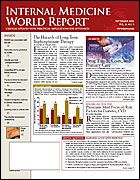Publication
Article
Internal Medicine World Report
Beware of Too-Aggressive BP Lowering in Patients with CAD
Author(s):
Ann Intern Med
The J-curve phenomenon?the paradoxically worse outcomes that have been observed with excessive blood pressure (BP) decreases?has been hotly debated. New research (. 2006; 144: 884-893) provides convincing, albeit not conclusive, evidence that there may be a basement threshold for diastolic BP beyond which the lives and well-being of patients with coronary artery disease (CAD) may become endangered.
Investigators took another look at data from INVEST (International Verapamil-Trandolapril Study), in which 22,500 patients (aged ≥50 years) with hypertension and CAD had been randomized to treatment with verapamil sustained release (eg, Calan SR, Isoptin SR) or atenolol (Tenormin) and then followed for an average of 2.7 years.
This secondary analysis revealed a J-shaped relationship between BP level, especially diastolic BP, and the primary outcomes of all-cause mortality and total myocardial infarction (MI) events, with risk increasing as diastolic BP level fell below 70 to 80 mm Hg. Lowering diastolic BP to ≤70 mm Hg resulted in a 2- to 3-fold increased risk for a primary outcome event (ie, all-cause death, first nonfatal MI, or first nonfatal stroke). The approximate 10% incidence of a primary outcome event associated with a diastolic BP of 71 to 80 mm Hg increased to 17% with a diastolic BP of 61 to 70 mm Hg and to 32% with a diastolic BP ≤60 mm Hg. Although INVEST participants who achieved a diastolic BP ≤70 mm Hg accounted for only about 11% of the total patient population, they experienced nearly 20% of all primary outcome events.
After adjusting for factors such as time to primary outcome and baseline heart failure, relative risk for all-cause death or first MI was slightly reduced, but the shape of the J-curve did not change. Nor did J-curves differ according to treatment with verapamil or with atenolol.
"Our observation of a J-curve in patients with CAD receiving treatment for hypertension does not establish a causal relationship, nor does it allow the conclusion that an inappropriate decrease in diastolic pressure with antihypertensive therapy causes the excessive morbidity," write Franz H. Messerli, MD, FACC Division of Cardiology, St. Luke's- Roosevelt Hospital, New York City, and colleagues.
They add, however, that "these findings emphasize that hypertensive patients with CAD and a lower diastolic pressure are at increased risk." The investigators argue that inappropriately lowering diastolic BP beyond "a certain critical level" may compromise myocardial perfusion, which occurs primarily during diastole, and could lead to cardiac ischemia.
While acknowledging that increased systolic BP, one of the strongest predictors of stroke and MI, is often undertreated, the authors conclude that their results coalesce with the cautionary advice offered in the latest recommendations of the Joint National Committee on Prevention, Detection, Evaluation, and Treatment of High Blood Pressure (JNC 7): When diastolic BP is low, patients with occlusive CAD are at risk for coronary events.
Key points
Whether excessive diastolic BP lowering can be dangerous is a subject of ongoing debate.
In a large trial using 2 antihypertensive regimens in patients with CAD, low diastolic BP level correlated with increased risk of all-cause mortality and first nonfatal MI.
The basement threshold for diastolic BP was between 70 and 80 mm Hg.
Whether "too much" diastolic BP lowering with antihypertensive therapy was the cause of the worse outcomes could not be determined.





